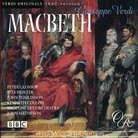10 greatest pieces of music by Verdi, ranked
31 May 2024, 10:03

From ‘La traviata’ to ‘Nabucco’, we explore the greatest works by the man who wrote some of the world’s greatest operas, 18th-century Italian composer Giuseppe Verdi.
Listen to this article
Giuseppe Verdi stands tall among the great Italian proponents of opera in the 19th century, a titan of the theatrical stage alongside Rossini and Donizetti.
Best known for his rousing choruses and stirring overtures, from La traviata to Rigoletto, his music has melded effortlessly into the 21st century, in the form of television ads, football chants, film soundtracks and more.
Distracted by a very brief spell as a politician elected to Italian parliament, Verdi spent more than 80 years filled with music-making of the highest order, honing his craft to become one of the greatest opera composers of all time.
Here are 10 of his all-time best.
Read more: Operatic tenor surprises pizzeria diners by bursting into a startling Verdi aria
-
Requiem
A truly colossal work: dramatic, delicate, and daring, the Requiem is the jewel that tops Giuseppe Verdi’s glittering crown. Originally conceived as a jointly-composed Requiem for the late Rossini, Verdi eventually completed the full work alone, in memory of the Italian philosopher Alessandro Manzoni.
A whopping 90 minutes in length, its most instantly recognisable movement is the ‘Dies irae’, a forceful two minutes in which the full orchestra and mass choir come together to incite the musical ‘Day of wrath’.
Read more: What are the lyrics and translation of Verdi’s ‘Dies Irae’?

Verdi’s Requiem: “Dies irae”
-
La traviata
Despite a disastrous reception at its premiere in 1853, La traviata is now one of Verdi’s most highly-acclaimed works of all time.
The opera itself is a tragedy, telling the story of two lovers who can’t seem to get their timing right, and are ultimately separated forever as Violetta succumbs to her tuberculosis.
Its most famous musical highlight, however, is overflowing with joy. ‘Brindisi’, also known as the ‘Drinking Song’, is a duet with a plucky waltz metre, sung amongst the merry-making that occurs between the ill-fated lovers that takes place long before fate darkens their door.
It’s no wonder that there were more productions of La traviata than any other opera in the world, in 2023.
Read more: This ‘Drinking Song’ from Verdi’s La traviata is a glass of pure musical joy

Vivacious Verdi! The ‘Drinking Song’ from La traviata | Classic FM Live
-
Aida
Set in ancient Egypt, Verdi was commissioned to write Aida in the late 1860s by Egyptian officials, to mark the opening of the newly-built Khedivial Opera House in Cairo. Unfortunately, the costumes for the production were stuck in Paris during a siege of the city, so Verdi’s Rigoletto opened the new theatre instead.
Aida eventually received its premiere at the Khedivial Opera House in 1871, to great acclaim. Its triumphant music, together with often-elaborate staging and ornate, glittering costumes, have secured its place in the opera canon and Verdi’s legacy as one of the great opera composers.

ENO Aida - Triumphal March ǀ English National Opera
-
Otello
After riding the adrenaline high from the lofty successes of Aida, Verdi was hesitant to write another opera. It took his publisher an entire decade to persuade him to look at the libretto by Arrigo Boito, based on Shakespeare’s Othello, and a further five years for the composer to complete the work.
Finally, in 1887 the first production of Otello made it to the stage. With three notoriously challenging lead roles, Verdi brought his all to the score of his penultimate opera, matching in music his great literary hero, William Shakespeare, who he called “the great searcher of the human heart.”
Read more: Italy’s opera houses hope to save Verdi’s historic home – by singing together

Sonya Yoncheva - Verdi: Otello, Ave Maria, piena di grazia
-
Falstaff
Verdi followed his great Shakespearean opera with another – Falstaff – in 1893. Now in his 80s, the great Italian master took a new approach to the music for his final opera. Rather than having the music neatly sectioned by aria, recitative, or incidental, Verdi wrote a continuous stream of music to his final work.
Like Shakespeare’s play before it, Falstaff is a tongue-in-cheek comedy, merry, mocking and musically marvellous.

Falstaff – Act I Scene II (Giuseppe Verdi; Jette Parker Young Artists)
-
Don Carlos
Standing at around four hours of music in full, Don Carlos is Verdi’s most monumental operatic achievement. Evoking the deep tragedy of the (mostly fictional) story of the (real-life) 16th century Prince of Asturias, Verdi’s 1893 opera is a masterclass in emotive orchestration.
Deeply moving, royally dramatic, with a plot that would put most soap operas to shame, a full-force production of Don Carlos is truly a spectacle to behold.
Read more: Incredible moment young opera fan stands up during soprano’s Verdi performance to sing tenor part

Maria Callas sings Verdi: Don Carlo: "Tu che le vanità" (Covent Garden, 1962)
-
Rigoletto
Even if you’ve never heard of Rigoletto before – or even Verdi – you’ve almost definitely heard its music.
Its most famous tune, ‘La donna è mobile’, has been used for everything from television adverts to pitchside football chants.
Verdi knew he had an earworm on his hands the moment he wrote it, refusing to give its premiere performer the sheet music until just before the very first performance. Even then, he was strictly forbidden from humming, singing, or whistling the melody outside of rehearsals. He obeyed, and lo and behold, the streets of Venice the following day were filled with the sound of ‘La donna è mobile’.
Read more: When Whitney Houston surprised the world with an extraordinary Verdi aria… with Luciano Pavarotti

Rigoletto - 'La donna è mobile' (Verdi; Vittorio Grigòlo, The Royal Opera)
-
Il trovatore
In the early 1850s, Verdi was in the midst of a musical frenzy. At the same time as he was working on Il trovatore, commissions came flooding in for Rigoletto, La traviata, and two other operas at the same time.
Whilst this busy schedule may have slowed progress somewhat, it certainly didn’t dampen Verdi’s creative spirits. From the rousing ‘Anvil Chorus’ to the hauntingly dramatic ‘Stride la vampa’, Il trovatore has firmly cemented itself as one of the great operas to this day.
Read more: Operatic chorus sings Verdi’s thunderous ‘Anvil Chorus’, raising the Royal Albert Hall roof

Verdi’s mighty Anvil Chorus raises the Royal Albert Hall roof | Classic FM
-
Nabucco
Based on stories from the Old Testament, Verdi’s biblical opera Nabucco was written after a particularly turbulent time in his personal life. Reeling from the poor reception of his second opera, tragedy struck further when his two infant children and 26-year-old wife died in close succession.
Devastated, Verdi vowed never to write another note. But gradually, over the course of a year, he was able to bring himself back to the manuscript paper to complete Nabucco by autumn 1841. ‘Va, pensiero’, often called ‘Chorus of the Hebrew Slaves’ is the best-known musical moment from the opera, a powerful solace-inspiring choral moment.

Giuseppe Verdi, Và pensiero (Nabucco)
-
La forza del destino
The Royal Opera House’s description of La forza del destino could not be more apt: the “engrossing psychological drama” was first performed in 1862, opening with a bone-chillingly dramatic ‘fate’ motif, which carries its way throughout the opera.
As if the drama of the opera itself wasn’t enough, La forza del destino has found itself at the heart of superstition in more recent years. Multiple production mishaps, and the death of one baritone onstage, earned it a cursed reputation so strong that Luciano Pavarotti refused to ever perform it.

Verdi. La Forza del Destino Overture - Karajan














